SENSATION AND PERCEPTION
Sensation: Detecting an external stim and converting it to a neural signal
—> Transduction: Process of converting stim energy (light, sounds, smells) into neural impulses our brain can interpret
Perception: selecting, organizing, and interpreting sensations
Bottom-up processing: analyzing stimulus starting with sensory working up to complex processing
Top-down processing: processing stimuli guided with higher-level mental processes, (constructing perceptions from expectations)
Psychophysics: Study of the relationship between physical characteristics of stimuli and our psychological experience with them
absolute threshold: the minimum amt of stim. needed to detect a stimulus 50% of the time
—>subliminal threshold: when the stimuli are below the absolute threshold for conscious awareness. (can still have a momentary, subtle effect on thinking and can invoke a feeling)
difference threshold (just noticeable difference): minimum difference needed to detect a difference between two stimuli 50% of the time.
—>Determined by: Amount of stimulus it began with, and which sense is stimulated
Weber’s Law: 2 stimuli must differ by a constant minimum percentage rather than a constant amount to perceive a difference. Varies among people
Signal Detection Theory (SDT): predicts when we can detect a weak signal amidst other stimuli, and assumes there is no single absolute threshold, it varies depending on experience, expectations, motivation, and fatigue.
—> Key Variables to detect a stimulus: Signal, Response, Noise, Response Bias
—>Trial Outcomes: Hit, Miss, False Alarm, Correct rejection
—> Conservative v Liberal response Bias: Tendency to favor a particular response when uncertain about if a stimulus is present.
> Liberal: 90% Hit, 10% Miss, 30% False Alarm, 70% Correct rejection
> Conservative: 60% Hit, 40% Miss, 10% False Alarm, 90% correct rejection
Priming: Unconscious activation of certain associations, predisposing one’s perception, memory, or response
—> ex: Kitten picture flashed before showing someone’s face > higher rating
sensory adaptation: diminished sensitivity as a consequence to constant stimulation, greater exposure = less sensitivity
Perceptual set: Set of mental tendencies and assumptions that affects what we hear, taste, feel, see, and top-down processing
VISION
Wavelength (Hue): the dimension of color is determined by the light’s wavelength (distance from one peak to another)
Amplitude (Intensity/Brightness): the amt of energy in a wave is determined by the amplitude
The eye:
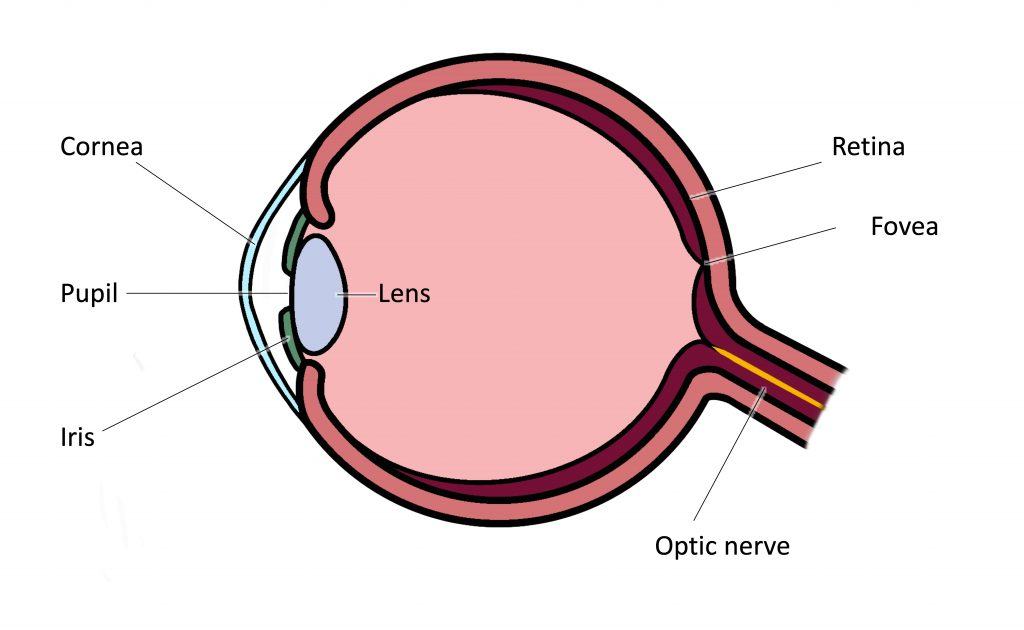
Cornea: protective transparent tissue where light enters
iris: colorful muscle that expands/contracts to let the light into the eye
lens: transparent struct. behind pupil that changes shape to focus the light rays onto the retina.
—>Accommodation: process in which the lens changes shape in order to help focus near/far objects onto retina
—> Myopia: nearsightedness (can see objs that are near) —>Hyperopia: farsightedness (can see far objs)
retina: light-sensitive inner surface of the eye which contains receptor rods and cones in addition to other layers of other neurons (bipolar ganglion cells), processes visual info
—>rods: Black and white vision, not sensitive to detail, works well in dim light, located in periphery, for motion perception
—> cones: colored vision, sensitive to detail, located in fovea, good for identifying
—>bipolar cells: receive info from photoreceptors(rods & cones) and transmit them to ganglion cells which proceeds info to optic nerve.
optic nerve: carries action potential from the eye to the brain (connects to thalamus which connects it to visual cortex in occipital lobe)
—>blind spot: no photoreceptors, where the optic nerve is
fovea: highest density of cones, sharpest vision
color processing stages:
Retina’s red, green. and blue cones respond in varying degrees to different color stimuli
Cone’s responses are then processed by opponent-processing theory
—> Trichromatic Theory (Young Helmholtz): retina has three color receptors (red, green, blue) which can be stimulated in combination to produce perception of any color >Humans have short, medium, and long wavelength cons (violet, 400nm » red, 700nm) > colorblindness: genetic deficiency, people are blind to red or green colors. missing one cone receptor type. sex-linked disorder (more common in males)
—>opponent-processing theory (Edwald Hering): opposing retinal processes (red-green, blue-yellow, white-black) enable color vision. Does not go against trichromatic theory, allows for another layer of complexity to color vision.
Feature Detection
Feature detectors (nerve cells) in the visual cortex respond to features (lines, edges, angles, movement) > David Hubel and Torsten Wiesel
Higher Level Processing: specific combinations of temporal lobe, activity occurs as people look at shoes, faces, chairs, houses, etc.
Parallel Processing: Processing several aspects of a the stimulus simultaneously
—> Dividing visual scene into subdivisions, (color, depth, form, movement, etc)
—> recognizing faces: Distributed over a vast network of cells, grandmother cells: respond very selectively to 1 or 2 faces in 100, uses 30% of the cortex
Sensation to recognition:
scene —>
retinal processing (receptor rods and cones > bipolar cells > ganglion cells > optic nerve > thalamus > visual cortex) —>
feature detection—>
parallel processing (combined info of color, movement, form, depth) —>
recognition (interpretations construct image based on info of stored images)
PERCEPTUAL ORGANIZATION
Gestalt Psychology: we form meaningful perception from sensory info by organizing it, whole is greater than the sum of its parts
Form perceptions (figure-ground): organizing our visual field into objects (figures) that stand out from their surroundings (background)
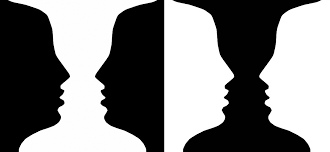
Perceptual grouping: our perceptions organizes figures into a meaningful form using grouping rules
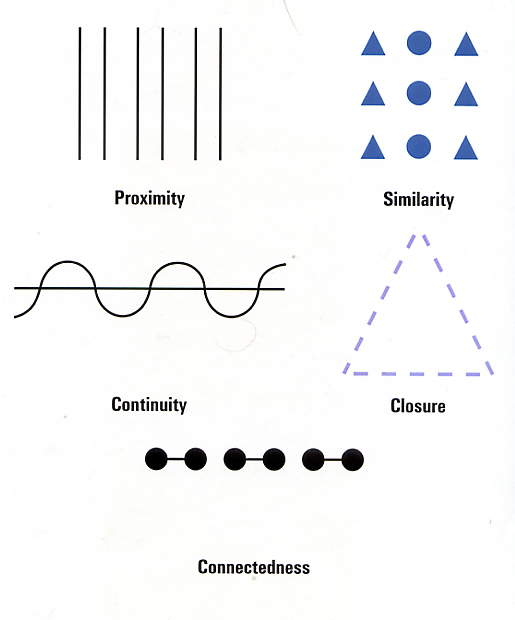
Depth Perception: Allows us to judge distances
—> visual cliff: laboratory device for testing depth perception in infants and young animals
—>binocular cue: depth cue, such as retinal disparity (the closer an obj is, the greater the diff of the image on each eye) relying on the use of both eyes
—>monocular cues:
>Relative Motion (motion parallax): objs perceived to be moving faster if closer and moving in the opposite direction
> Linear perspective: parallel lines converge more as distance increases
> light and shadow: nearby objs reflect more light onto eyes, dimmer=farther
>relative size: if two objs are similar in size, we see a smaller cast retinal image, it seems farther
>Interposition: objects that block other objs are closer >relative height: objs that are in our higher field of vision are farther
Motion Perception: Shrinking objects are retreating, growing objects are approaching
Phi phenomenon: illusion of movement created when two or more adjacent lights blink on/off in quick succession (like flipbook animations)
Perceptual constancy: perceiving objs as unchanging even as illumination and retinal images change
—>color constancy: perceiving familiar objs as having consistent color even when changing illumination filters the light reflected by the obj. (these strawberries are actually grey)
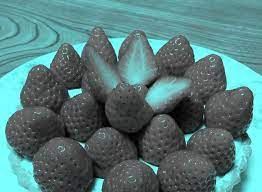
—>lightness/brightness consistency: relative illuminance- amt of light objs reflect is relative to its surroundings
shape constancy: we perceive the form of familiar objs as constant even while retinas receive changing images (Visual cortex neurons rapidly learn to associate different views of an obj)
size constancy: we perceive an obj as having an unchanging size even while our distance from it varies.
perceptual interpretations
—>Immanuel Kant (1724-1804): maintained than knowledge comes from our inborn ways of organizing sensory experiences
—>John Locke (1632-1704): argues we learned to percieve the world through our experiences
—>Critical period: For normal sensory/perceptual development, optimal period when exposure to certain stimuli or experience is required
Perceptual adaptation: visual ability to adjust to an artificially displaced visual field
HEARING (AUDITION)
Mechanical Waves: compressing/expanding air molecules
frequency(pitch): amount of waves passing a certain point in a certain amount of time, depends on wavelength
intensity(volume): amplitude
timbre: character/quality of a musical sound/voice as distinct from pitch/intensity
The ear
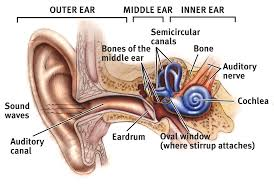
Outer Ear (Collect + Amplify): collect and send sounds from auditory canal to ear drum (aka tympanic membrane)
Middle Ear (amplify + transfer): chamber containing the ossicles (hammer/malleus), and anvil that concentrate vibrations of the eardrum to the cochlea’s oval window
Inner ear (transfer + transduce) : contains cochlea (coiled, bony, fluid-filled tube where hair cells on basilar membrane transduce sound vibrations into auditory signals), semicircle canals, and vestibular sacs. Transduces mechanical waves to neural signals
Audition Process:
ear canal > ear drum > ossicles > oval window > cochlea > hair cells on basilar membrane > auditory nerve > thalamus > auditory cortex in temporal lobe
sensorineural hearing loss (nerve deafness): damage to cochlea’s receptor cells or auditory nerves; most common form of hearing loss
conduction hearing loss: damage to mechanical system that conducts soundwaves (cochlea)
—>cochlear implant: device that can convert sounds into electrical signals and stimulating auditory nerve through electrodes threaded into the cochlea
Place theory: frequency determines place/position in basilar membrane of which the sound is transduced (high freq waves: near close end, low freq waves: peak at far end). accounts well for high-pitched sounds but not for low
Frequency theory: rate of neural impulses traveling up auditory nerve matches the freq of a tone, enabling us to sense a pitch. accounts well for low pitched sounds, but not for high
—>individual neurons can only fire at a max of 1000x/s
—>volley principle: neural cells can alternate firing to achieve a combined freq of 4000 x
localization of sounds: 2 ears can help find sound source
TOUCH
Sense of touch is a mix of pressure, warmth, cold, and pain
gate-control theory (Melzack and Wall, 1965, 1983): our spinal cord has neurological ‘gates’ that can block/allow pain to be sensed. pain signals travelling up small nerve fibers open the gates causing pain and gates closed by signals in larger fibers can alleviate pain.
(Pain can be distracted/controlled: drugs, surgery, acupuncture, hypnosis, exercise)
Biological influences on pain: activity in spinal cord’s large/small fibers, genetic endorphin production, brain’s interpretation of CNS activity
social-cultural influences: other’s presence, empathy for other’s pain, cultural expectations
psychological influences: attention to pain, learning based on experience, expectation of pain relief (placebo)
Kinesthesis: receptors in muscles tendons and joints sense our body’s position/movement
vestibular sense: fluid in the semicircular canals and vestibular sacs in the ear move when head moves and sends signals to the cerebellum, allows us to sense head/body position and maintain balance
TASTE
(gustation) chemical sense: sweet, salty, sour, bitter, umami
SMELL
(olfaction): chemical sense. odorants enter nasal cavity to stimulat 5 million receptors to sense smell. many forms of smell
—> smell and memories: smell neural signals dont go through thalamus, the brtain region for smell is very close to the memory brain region (limbic system), which is why strong memories are linked with smell
sensory interaction: when one sense affects the other
—> synesthesia: one sensation produces another
Vestibular sense: balance.
kinesthesia: where our body is.